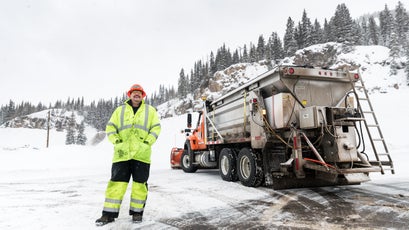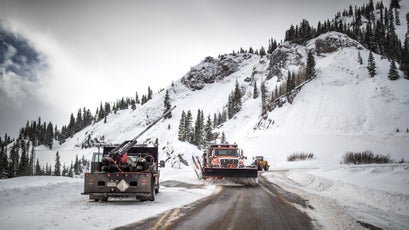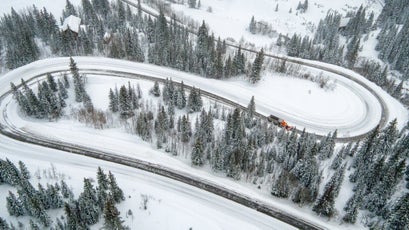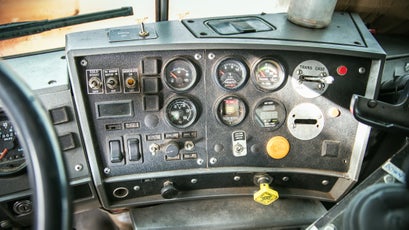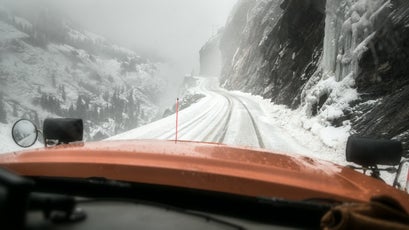Keep Your Hands on the Wheel and DonŌĆÖt Look Down
The most perilous road in America gets 300 inches of snow a year, features 70 named avalanche paths, and has almost no guardrails. Who would be bold enough to keep ColoradoŌĆÖs infamous Highway 550 clear in winter? Leath Tonino hopped into the cab of a Mack snowplow truck to find out.
New perk: Easily find new routes and hidden gems, upcoming running events, and more near you. Your weekly Local Running Newsletter has everything you need to lace up! .
ItŌĆÖs an exceedingly white January afternoon on AmericaŌĆÖs sketchiest roadŌĆöwhite ┬Łflurries rushing the windshield and swirling in the ┬Łmirrors, white ridges and cirques disappearing among torn white clouds. Heck, even the road is white, though it wonŌĆÖt remain so for long. Dack Klein is behind the wheel of his 18-ton Mack plow truck, laughing his big laugh, navigating yet another lethal curve with all the casual confidence of a man who has done this some 7,000 times before. Or maybe itŌĆÖs 8,000 times.ŌĆŗ
An equipment operator with the ┬Ł (CDOT), Klein has worked the 15 miles of U.S. Highway 550 that climb from Ouray to the top of 11,018-foot Pass since 2003. He has worked them at dawn and midnight, on Halloween and Easter and Cinco de Mayo. He has worked them in every imaginable type of blizzardŌĆöfrom the fierce to the downright savage, from the protracted to the never-ending.
Forty-two years old, with a black buzz cut, a stout build, and a probably-should-have-died crash under his belt, Klein is famil┬Łiar with every inch of Red Mountain Pass. A typical shift for one of the four full-time ┬Łemployees stationed at Ouray lasts eight hours but will stretch to 12 or 18 when the weather insists. Weekends are more of a theoretical possibility, monthlong runs of consecutive days to be expected. Between late September and early June, Klein spends half as much time with his wife and three kids as he does with his Mack, doing the job, which he calls ŌĆ£pushing.ŌĆØ
Milepost 90, passing below an : ŌĆ£YouŌĆÖve got to appreciate the dangers when youŌĆÖre pushing. Last winter we had a chunk of rock the size of a football field detach right here.ŌĆØ
Milepost 87, entering , the roadŌĆÖs only flattish section: ŌĆ£There have been nights I could barely see past the wipers when I was pushing. It can take 20 minutes to manage this one nasty mile if itŌĆÖs blowing.ŌĆØ
Milepost 81, beneath Blue Point: ŌĆ£The saying goes that Blue Point will run if you sneeze. Usually itŌĆÖs a bank slip, but occasionally itŌĆÖs a giant, and then youŌĆÖve got to do some serious pushing.ŌĆØ
Milepost 80.28, at the summit: ŌĆ£Jackknifed 18-wheelers, four feet of fresh powder in eight hoursŌĆöpushing on Red gets ┬Łcrazy. But thatŌĆÖs what makes it special, right?ŌĆØ
The San Juan Mountains average 349 inches of snow annually, and much of it falls twice: first from the sky, then from the crests and headwalls where it tries, and fails, to cling. Seventy named avalanche paths┬Āintersect Highway 550 in the 23 miles between Ouray and Silverton, the town on the south side of the pass that serves as a base for another of CDOTŌĆÖs 200 patrols across the state. The infamous East Riverside slide can dump 50 feet of concrete-thick debris and has ŌĆöin 1970, 1978, and 1992ŌĆöas well as a preacher and his two daughters in 1963, and two men and most of their team of mules in 1883. Since 1935, when the first attempts to keep the road open through winter were made, dozens of people have perished trying to get across, though an exact number is impossible to tally.
The threats are numerous: soaring cliffs, towers of brittle ice, 8 percent grades, unexpected doglegs. I spoke with Klein over the phone, and he explained that the lower portion of the road is literally chiseled into the vertical rock of the Uncom┬Łpahgre GorgeŌĆöa narrow geologic throat 1,000 feet deep in places. The upper portion, beyond Ironton Park, traverses subalpine slopes largely scoured of trees. We talked for 15 minutes and he used the word respect often enough that I lost count. He also exuded a kind of pure, almost childlike enthusiasm for the elemental power of the range, the clarity of purpose his job engenders, and what he called his ŌĆ£Tonka truck.ŌĆØ
By the end of the conversation, an invitation was on the table: come ride.
So here we areŌĆöinside KleinŌĆÖs shiny ┬Łorange 4×4 Mack, a crucial player in a fleet that also includes a grader, a blower, a pair of loaders, and two other plows. ItŌĆÖs mid-January 2016. A three-day storm kept the Ouray patrol pushing straight through Christmas, and a fresh one is gathering. Our 12-foot rubber-┬Łcoated carbide blade is lowered, our ten-foot wing extended on its hydraulic arms, jutting from behind the passenger-side door, forcing snow farther off the road. The rig is 13 feet tall, costs $200,000, gets two and a half miles to the gallon, and fills the lane like a football player in a too-small suit. Three hundred and twenty-five horses snort beneath the broad hood. The cab is richly perfumed with diesel fuel, warm and snug.
ŌĆ£Less spacious than your Toyota Tercel,ŌĆØ Klein says with a grin after I mention the make and model of my car. ŌĆ£Little for comfort, but a blast to drive.ŌĆØ
Spacewise, the cab is indeed reminiscent of a compactŌĆöand thus concludes the vehicular similarities. WeŌĆÖre lording over F-350ŌĆÖs, enthroned seven feet off the ground, a sand-salt mix spraying from a massive hopper mounted to the truckŌĆÖs rear. Electronics abound: ground thermometers, GPS tracking systems, so many screens and gauges one thinks of an airplane cockpit. A toolbox at my feet contains emergency suppliesŌĆöMREs, rope, a space blanket, a Maglite, a wrenchŌĆöand at my elbow, Klein has wedged in an additional backpack loaded with enough food, water, and clothing to last at least two days. Avalanche beacons strapped to our chests blink, their batteries fresh.
Having tagged the top of the pass 3,200 feet above Ouray and pulled a U-turn, Klein and I are now descending Upper Switchbacks, a set of precarious zigzags balanced on the mountainŌĆÖs steep face. Pressing my nose to the window, what I notice is an ┬Łabsence. Despite the narrow shoulder and stomach-tightening exposure, there are no guardrails in sight. (A few exist along the route, but they are rare.) The reason, IŌĆÖm told, is simple: plow drivers have to put all that snow somewhere. On Highway 550, that somewhere is over the edge.
ŌĆ£WeŌĆÖve got nicknames for everything,ŌĆØ Klein says. ŌĆ£PaulŌĆÖs Plunge, Scary LarryŌĆÖs Rock, Upper Switchbacks, DackŌĆÖs Dilemma.ŌĆØ
The dilemma occurred in 2007 on a typical Red Mountain night: temperatures in the single digits, bad gusts, snow flying in every direction. Visibility was a few notches below poor, and a terrified kid in a sedan was hogging both lanes, approaching Klein head-on. Given the conditions, this member of the ŌĆ£traveling public,ŌĆØ as Klein affection┬Łately calls such drivers, probably should have been at home playing video games or making out with his girlfriend. Klein slowed his rigŌĆöhe was only doing about ten miles per hour to begin withŌĆöand eased to the side of the road. A bit too far, it turned out.
ŌĆ£It was this slow-motion tilting,ŌĆØ he says, recalling what happened next. ŌĆ£I kind of reached for my seat belt, reached for the door, thinking maybe I could jump out, but there wasnŌĆÖt enough time.ŌĆØ Picturing his wife asleep in their house at the bottom of the pass, her belly round and pregnant, he gripped the wheel and ŌĆ£went for the ride.ŌĆØ
Klein dropped 60 feet before the truckŌĆÖs cab crumpled around his body with a ┬Łsickening metallic crunch, his Mack coming to rest upside down on the road. A lower switchback had caught him, nearly killed him, and saved his life, all at once. Bruised but otherwise uninjured, he tried to kick through the windshield. Ten long minutes later, when a car stopped nearby, he was still kicking. His rescuers were absolutely hammeredŌĆö knocking back beers, aimlessly touring the stormŌĆöbut their drunken hearts were in the right place. They bashed the glass, pulled Klein free, and stuffed him in among the dozens of empties in their back seat.
ŌĆ£I didnŌĆÖt think the roll messed with me,ŌĆØ Klein says. ŌĆ£But ever since, IŌĆÖve had trouble getting over toward the lip in this spot. IŌĆÖm fine everywhere else, but at this spot itŌĆÖs like my body wonŌĆÖt allow it. I just canŌĆÖt get over as far.ŌĆØ
With that, the memory residing in his hands takes the wheel and tugs gently left, inching us away from the shoulder and the void beyond.
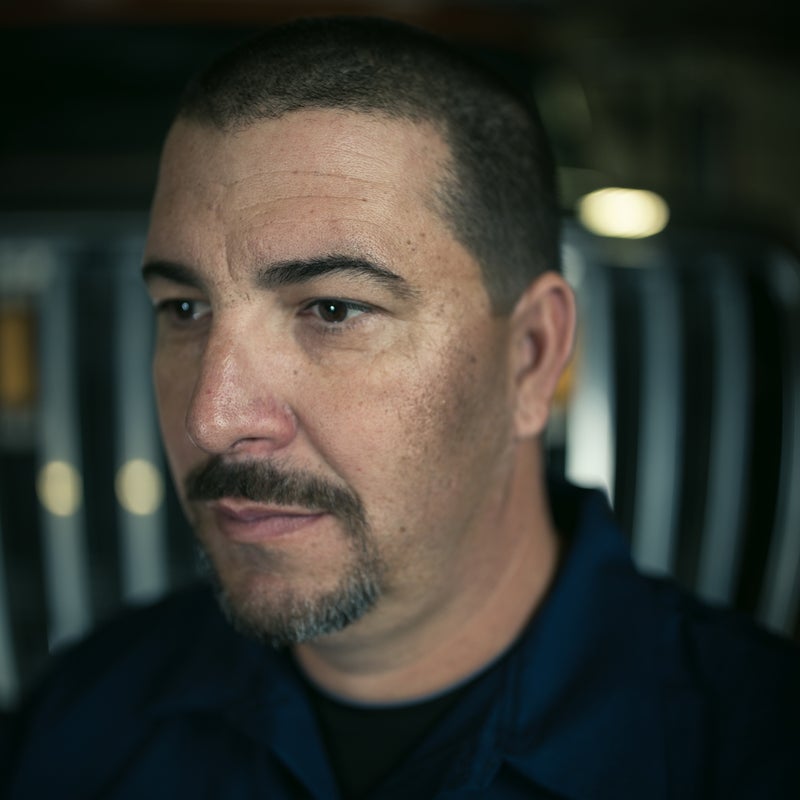
Klein and his colleagues refer to this behaviorŌĆöcheating the yellow line a bit, erring on the side of cautionŌĆöas ŌĆ£favoring the mountain.ŌĆØ They refer to snow falling at a rate of a quarter-inch per hour or less as ŌĆ£nuisance snowŌĆØ and to scraping compressed snow from the pavement as ŌĆ£peeling pack.ŌĆØ They refer to a job well done as ŌĆ£safe enough for your mother.ŌĆØ Neighboring patrols out of Silverton, Ridgeway, Cascade, and Norwood are ŌĆ£extended familyŌĆØ and are accordingly the target of much good-┬Łnatured trash talk regarding whoŌĆÖs ŌĆ£keeping it prettyŌĆØ and whoŌĆÖs ŌĆ£falling behind.ŌĆØ
OurayŌĆÖs four and a half driversŌĆötwo on the day shift, one on swing from 4 p.m. to midnight, one on graveyard, and a part-time backup for ŌĆ£when things fall apartŌĆØŌĆö┬Łmaintain fewer miles of road than almost any other CDOT patrol, which is a testament to both the local terrain and the rowdy weather. In the summer, they do road maintenance, but the real test comes with the snow. Drivers complete a weeklong course in plowing before they start the job. They receive a 10 percent ŌĆ£hard to fillŌĆØ bonus atop a starting salary of around $3,000 or $4,000 per month. The ┬Łseven-bay garage at the begin┬Łning of Highway 550ŌĆÖs ascent from the south end of Ouray brims with bull plows, rotary blades, chin-high tires, and Peewag chains for increased traction. Some drivers prefer the rhythm of a career in, say, metro Denver. .
There are dozens of treacherous passes in the American West. Colorado alone boasts Lizard Head (48 avalanche paths), Berthoud (25), and Monarch (19). But none compare to . In addition to Red, this portion of the road includes Molas Pass (50 paths) and Coal Bank Pass (20 paths), both south of Silverton. ItŌĆÖs the most avy-prone road in the lower 48.
The slides are colossal. Some of the starting zones span hundreds of acres, release 150,000 cubic meters of snow, and generate wind speeds in excess of 200 miles per hour. Add to these monstrous forces the ŌĆÖs gaping maw and you get the well-worn CDOT expression: ŌĆ£If the slide donŌĆÖt kill you, the sudden stop at the bottom will.ŌĆØ
“‘At midnight IŌĆÖd drive by and she would flicker the lights in her window and IŌĆÖd flicker my headlights back. You know, it was a way to say, ŌĆśYou can go to sleep now, Mother. I survived ┬Łanother night.'”
Ouray is a small townŌĆö800 residents on a seven-block grid that appears lifted from a snow globeŌĆöand is made smaller by its surroundings. Brute origami comes to mind, as though a trillion postcards of sublime scenery have been folded and refolded into an orogenic Frankenstein. The topography is unavoidable, the mountain range young and sharp and everywhere, rocketing 5,000 feet from the sidewalks.
In 1993, a year after the third plow ┬Łdriver died at East Riverside, CDOT got serious about managing road-threatening slides and began a collaboration with the Colorado Avalanche Information Center (CAIC) that continues to this day. No one has been killed by an avalanche while driving the pass since, thanks to a mixed strategy involving teams of forecasters nerding out on the snowpack, gates that can lock the road shut when necessary, and explosives.
Take for example the Christmas 2015 blizzard. The sky dumps and keeps dumping. A CDOT driver, eyes burning and head aching from a tough shift, gets on the radio. ŌĆ£Hey boss,ŌĆØ he says, ŌĆ£I think it might be time to close her down.ŌĆØ Meanwhile, two CAIC forecasters stationed in Silverton, and one stationed in Ouray, have been eyeing the Doppler radar, monitoring the slopes, cruising the road at ungodly hours, worrying themselves sleepless over ŌĆ£whatŌĆÖs getting loadedŌĆØ and ŌĆ£what wants to run.ŌĆØ More calls, more conversation, and more snow finally lead to a decision from CDOT headquarters: OK, lock the gate.
Ambulances, commercial truckers, and crazed snowboarders in need of a pow fix rely on the road being open, which means that the locked gate represents a ticking clock. Mitigation usually starts when the weather cooperates, often around six in the morning. According to , crews can employ any of the following to trigger slides: ŌĆ£5-pound charges set by hand; a truck-mounted ŌĆśavalauncherŌĆÖ that uses pneumatic pressure to fire 2.2-pound rounds; a 105 Howitzer leased from the Army that can fire 40-pound missiles up to seven miles; a helicopter that drops 30- to 50-pound bombs.ŌĆØ The debris, once down, doesnŌĆÖt move on its own, and so they start pushing again, the clock still ticking. Klein has occasionally found himself working the Mack, the guns, and the front-end loader all in one slog of a shift.
ŌĆ£Every runŌĆÖs different,ŌĆØ says Elwood Gregory, who plowed the road from 1979 to 1986. A mustached 77-year-old with a bald head, he misses ŌĆ£the thrill of battling Red.ŌĆØ
ŌĆ£You come around a corner and thereŌĆÖs an ermine in the road, or a ptarmigan, or a crippled elk that got swept away by a slide. Or you come around and headlights are shooting out of the gorge, straight into the air. One time I saw a car burning down there, flames and everythingŌĆöturned out that a guy had murdered his wife and sent her over.ŌĆØ
ŌĆ£What about your family?ŌĆØ I ask. ŌĆ£What did they think about your work on Red?ŌĆØ
ŌĆ£My wife understood how much I enjoyed it, so she was fine,ŌĆØ he says. ŌĆ£It bothered my mother, though. Her house was right there at the bottom of the hill. At midnight IŌĆÖd drive by and she would flicker the lights in her window and IŌĆÖd flicker my headlights back. You know, it was a way to say, ŌĆśYou can go to sleep now, Mother. I survived ┬Łanother night.ŌĆÖ ŌĆØ
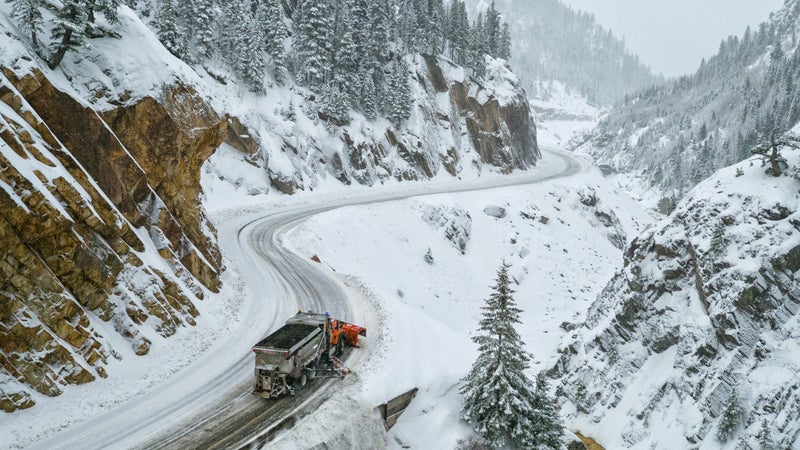
Another night. It should be a bumper sticker slapped onto every CDOT truck. During my first afternoon ride with Klein, he emphasized that Red Mountain Pass morphs into a ŌĆ£different creatureŌĆØ with the fading of duskŌĆÖs alpenglow. The guys rotate shiftsŌĆötwo months of days, two months of swings, two months of gravesŌĆöto share the burden. That order comes apart under the weight of heavy weather, though, ┬Łeverybody pushing together to make the road safe regardless of whose shift it is. And even when the snow ┬Łfinally quits, there are rocks to clear, vehicles to fix, a whole series of tasks to prepare for the next big dump.
ŌĆ£The storms usually come after dark,ŌĆØ Klein says. ŌĆ£CliffordŌĆÖs on graves, but heŌĆÖs been puking with some kind of flu, so I donŌĆÖt think you want to seal yourself into a truck with him for eight hours. WeŌĆÖve got to make sure you ride with Michael on swing.ŌĆØ
Michael Harrison is a 52-year-old from ChicagoŌĆÖs South Side who moved to the San Juans after college and still retains the accent of his childhood. (He stopped working on the patrol before the 2016ŌĆō17 season.) Compared with the ebullient Klein, he is a monk of the road, focused and intense. ŌĆ£ItŌĆÖs fucking spooky up there,ŌĆØ he says. ŌĆ£Really fucking spooky. You sure you want to do this?ŌĆØ
ŌĆ£These dudes gave their lives to keep the road open, East Riverside took them all. Different events, but the same slide.ŌĆØ
The weather thatŌĆÖs been growing on the pass is finally peaking, snow falling at three inches per hour. Harrison just finished his first run, and already his efforts are close to erased. ThereŌĆÖs no time to waste. Clean gunk-ice from the lights, load the hopper with sand, and go. Rule number one of plowing: push with the storm.
As we drive, the temperature dives to two degrees in the gorge, visibility tightens to 25 feet, and the wind makes a menagerieŌĆÖs worth of animal sounds. Harrison says nothing, his right hand working the three joysticks that adjust the angle of the plow and wing, while his left hand stays steady on the wheel. WeŌĆÖre low-┬Łbeaming it, squinting, billions of snowflakes flashing in our yellow and blue strobes.
What by day felt like an airplane cockpit presently feels like a spaceship. Town is gone for good, a distant planet, a false memory of security and laughter and cheery neon lights in tavern windows. The 1,000-foot abyss yawns invisibly to our right.
Milepost 90, passing Ruby Walls: ŌĆ£In sideways weather, IŌĆÖve got to be able to get out of the truck, take three steps, and touch the mountain. If I can touch the mountain, IŌĆÖm safe. If I canŌĆÖt, that means the mountain might drop out from under my tires.ŌĆØ
Milepost 87, entering Ironton Park: ŌĆ£Sometimes I catch myself saying, ŌĆśWhereŌĆÖs the road?ŌĆÖ IŌĆÖll be humming to myself: ŌĆśWhereŌĆÖs the road? WhereŌĆÖs the road?ŌĆÖ ŌĆØ
Milepost 81, beneath Blue Point: ŌĆ£This is definitely the letŌĆÖs-get-the-fuck-out-of-here section. You see these sloughs spilling across our lane? They came down in the last hour. ThatŌĆÖs bad. We call those indicator slides. They mean trouble.ŌĆØ
Milepost 80.28: ŌĆ£ItŌĆÖs life and death up here, no doubt. People think you can just drop a plow and go for it, but you canŌĆÖt. ThatŌĆÖs why so many CDOT drivers donŌĆÖt want anything to do with Red Mountain Pass. If you make a mistake, it will probably be your last. YouŌĆÖve got to be on it. YouŌĆÖve got to be in tune. YouŌĆÖve got to be in the game, totally in the game.ŌĆØ
Minutes later, creeping back down ┬Łtoward Ouray, Harrison downshifts as we approach milepost 88. ŌĆ£IŌĆÖm going to pull over for a second,ŌĆØ he says. ŌĆ£I want you to see the Monument.ŌĆØ
We adjust our safety helmets over our wool hats, open the doors, and exit into knee-deep powder. Inside the truck, the weather is something to fear and respect. ╣·▓·│į╣Ž║┌┴Ž it simply isŌĆöequal parts motion and stillness, chaos and calm, violence and peace.
Harrison trudges into a drift, pulls a Maglite from his pocket, and shines it over a polished slab of granite that is fast on its way to being buried. Below the engraved image of a plow truck almost identical to the one idling behind us, I read three names and dates: ROBERT MILLER (MARCH 2, 1970), ┬ĀTERRY KISHBAUGH (FEBRUARY 10, 1978), EDDIE IMEL (MARCH 5, 1992).
ŌĆ£These dudes gave their lives to keep the road open,ŌĆØ Harrison says. ŌĆ£East Riverside took them all. Different events, but the same slide.ŌĆØ
We stand there for a minute, maybe less, the names on the stone disappearing beneath so many weightless flakes. Soon enough the engraved plow will be resting on its own white road.
ŌĆ£The mountainŌĆÖs got a lot of different moods,ŌĆØ Harrison says finally, without turning toward me. ŌĆ£In its own sick little way, it can be kind of magical.ŌĆØ
He switches off the Maglite and tilts his face to the sky.
ŌĆ£I guess weŌĆÖd better get back to pushing. ItŌĆÖs really coming down now, isnŌĆÖt it?ŌĆØ
│ó▒▓╣│┘│¾╠²░š┤Ū▓įŠ▒▓į┤Ū╠²wrote about soundscape ecologist Bernie Krause in the January/February 2016 issue.



